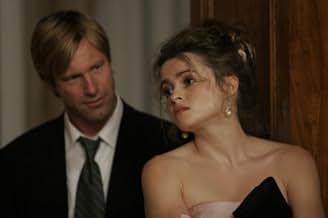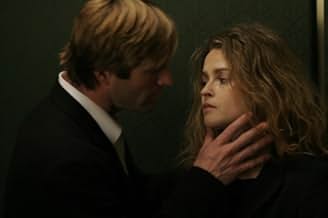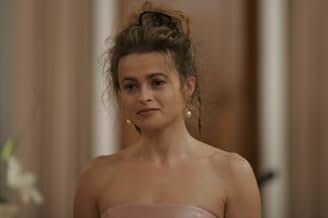IMDb RATING
6.9/10
13K
YOUR RATING
When a man and woman flirt with each other at a wedding reception, the sexual tension seems spontaneous. As they break from the party to a hotel room, the flirtation turns into a night fille... Read allWhen a man and woman flirt with each other at a wedding reception, the sexual tension seems spontaneous. As they break from the party to a hotel room, the flirtation turns into a night filled with passion and remorse.When a man and woman flirt with each other at a wedding reception, the sexual tension seems spontaneous. As they break from the party to a hotel room, the flirtation turns into a night filled with passion and remorse.
- Awards
- 3 wins & 4 nominations total
Veronica Reyes-How
- Girl on Street
- (as Veronica Reyes)
Noah Abrams
- Partygoer
- (uncredited)
Will Carter
- Wedding DJ
- (uncredited)
Madison Davenport
- British Girl
- (uncredited)
- Director
- Writer
- All cast & crew
- Production, box office & more at IMDbPro
Featured reviews
There are so many conventional movies about adulterous chance meetings that the prospects of another one wouldn't seem to be too promising. However, director Hans Canosa takes a rather novel approach with this small-scale 2006 indie film in looking at the illicit one-night stand with a pervasive split-screen process. Most often, the two sides reflect the perspectives from the man and woman at the center of the story, and at other times, we see their individual memories as flashbacks to their youthful courtship. Initially, the gimmicky aspect of watching the duality of the action is rather jarring, but it gradually becomes a dramatically effective means for exhibiting the dynamics of the two characters in real time. Gabrielle Zevin's sharply delineated, often amusing dialogue also helps to bring an immediacy to what could have been a predictably drawn situation.
The intimate, verbose plot itself turns on several contrivances, some more forgivable than others (like the absence of names for the lovers and the misunderstanding arising from matching cell phones). Regardless, it's really the adroit charm and emotional dexterity of the actors that sets this movie apart. Playing yet another rascally man-child, Aaron Eckhart adds shades of mid-life romantic vulnerability that make his character likeably flawed. But the picture really belongs to Helena Bonham Carter's richly textured performance as the woman, easily her best work since 1997's "The Wings of the Dove". As a complacent married woman who feels herself hurtling palpably toward forty, she provides such revealing nuance with each scene that I ended up wondering more about her character's fate than his. With her sad dark eyes and pouty mouth, she looks more like legendary French actress Jeanne Moreau as the years pass.
Shot in only thirteen days and with a running time of only 84 minutes, the movie is quite small in scope, but it is also a relatively undiscovered gem that will hopefully take on new life on DVD. Speaking of which, the 2007 DVD has a surprisingly robust number of extras beginning with Canosa's thoughtful commentary track. Also included are an entertaining 25-minute interview with an easily bantering Eckhart and Carter from the Telluride Film Festival; an insightful five-minute short with the director showing a demo of his dual-camera film-making technique; a helpful four-minute explanation of why split-screen was used specifically for the film; and a less interesting, more technical twenty-minute demonstration of how Canosa used Apple Final Cut Pro software to make his complex edits.
The intimate, verbose plot itself turns on several contrivances, some more forgivable than others (like the absence of names for the lovers and the misunderstanding arising from matching cell phones). Regardless, it's really the adroit charm and emotional dexterity of the actors that sets this movie apart. Playing yet another rascally man-child, Aaron Eckhart adds shades of mid-life romantic vulnerability that make his character likeably flawed. But the picture really belongs to Helena Bonham Carter's richly textured performance as the woman, easily her best work since 1997's "The Wings of the Dove". As a complacent married woman who feels herself hurtling palpably toward forty, she provides such revealing nuance with each scene that I ended up wondering more about her character's fate than his. With her sad dark eyes and pouty mouth, she looks more like legendary French actress Jeanne Moreau as the years pass.
Shot in only thirteen days and with a running time of only 84 minutes, the movie is quite small in scope, but it is also a relatively undiscovered gem that will hopefully take on new life on DVD. Speaking of which, the 2007 DVD has a surprisingly robust number of extras beginning with Canosa's thoughtful commentary track. Also included are an entertaining 25-minute interview with an easily bantering Eckhart and Carter from the Telluride Film Festival; an insightful five-minute short with the director showing a demo of his dual-camera film-making technique; a helpful four-minute explanation of why split-screen was used specifically for the film; and a less interesting, more technical twenty-minute demonstration of how Canosa used Apple Final Cut Pro software to make his complex edits.
I saw this at the LA Film Festival and frankly was expecting it to be very artsy, interesting, and a real downer. It was far above all those things. The split screen is easy to adjust to and really wraps you in, you're quite fascinated to see what these two people will do next. I loved the set up; it lent itself to a nice surprise for the audience and felt completely natural.
What really shines in this movie is the dialog...it's some of the most brilliant original dialog between two people with a shared past that I've ever heard. During the Q&A afterward, I was actually a bit disappointed the director didn't give the screenwriter more credit for her amazing script (which she wrote in three weeks). It's so engaging and natural, you might guess it was improvised...but 99% came directly off the page.
Helena Bonham Carter and Aaron Eckel really landed plum roles for themselves in this story and I've never loved them more than here. The reviewer who thought Helena was miscast is way off in his perception. It's not about wedding sexual tension (good grief) and it's far from a chick flick...it's about the deep connection between two people regardless of time and similar to "Before Sunrise," etc., yet quite different, but I don't want to spoil it.
The film is touching, very humorous, and deeply thoughtful. You will want to watch it several times to catch all that happens.
What really shines in this movie is the dialog...it's some of the most brilliant original dialog between two people with a shared past that I've ever heard. During the Q&A afterward, I was actually a bit disappointed the director didn't give the screenwriter more credit for her amazing script (which she wrote in three weeks). It's so engaging and natural, you might guess it was improvised...but 99% came directly off the page.
Helena Bonham Carter and Aaron Eckel really landed plum roles for themselves in this story and I've never loved them more than here. The reviewer who thought Helena was miscast is way off in his perception. It's not about wedding sexual tension (good grief) and it's far from a chick flick...it's about the deep connection between two people regardless of time and similar to "Before Sunrise," etc., yet quite different, but I don't want to spoil it.
The film is touching, very humorous, and deeply thoughtful. You will want to watch it several times to catch all that happens.
Hans Canosa makes a strong debut with Gabrielle Zevin's intelligent screenplay (read two character dialogue) CONVERSATIONS WITH OTHER WOMEN and while some viewers may be distressed about his choice of use of the split screen presentation, Canosa's decision to be the editor of the film makes a strong argument for his artistic decision. We are able to not only see ell sides of the characters physically, but we are also allowed to step into the 'private space' created by each of the characters, a space that grows in meaning as the film proceeds. For this viewer it enhances the story.
It would be difficult to imagine two finer actors than Helen Bonham Carter and Aaron Eckhart to pull off this story. Bonham Carter has flown in form London as a last minute replacement bridesmaid for an old friend and is bored by the wedding until she encounters Aaron Eckhart whom we soon learn is the bride's brother. But coincidences don't stop there: soon the couple decide to have a night together and as they begin to share their current uncomfortable lives they recall that they were young lovers (well played by Erik Eidem and Nora Zehetner in flashbacks) and more than likely were married as first marriages.....but to say more would ruin the repartee that these two brilliant actors enjoy playing against each other.
Canosa manages to create a solid interplay between his actors and then capitalizes on the gifts of each by placing them in simultaneous and revealing views that more that provides his rationale for using the split screens as his technique. Bonham Carter is more beautiful than ever and proves she is one of our finest actresses on film, seen far too seldom these days. CONVERSATIONS WITH OTHER WOMEN is a sly look at relationships that slowly creeps up on you as you learn the secrets of each character. It is a fine piece of film-making! Grady Harp
It would be difficult to imagine two finer actors than Helen Bonham Carter and Aaron Eckhart to pull off this story. Bonham Carter has flown in form London as a last minute replacement bridesmaid for an old friend and is bored by the wedding until she encounters Aaron Eckhart whom we soon learn is the bride's brother. But coincidences don't stop there: soon the couple decide to have a night together and as they begin to share their current uncomfortable lives they recall that they were young lovers (well played by Erik Eidem and Nora Zehetner in flashbacks) and more than likely were married as first marriages.....but to say more would ruin the repartee that these two brilliant actors enjoy playing against each other.
Canosa manages to create a solid interplay between his actors and then capitalizes on the gifts of each by placing them in simultaneous and revealing views that more that provides his rationale for using the split screens as his technique. Bonham Carter is more beautiful than ever and proves she is one of our finest actresses on film, seen far too seldom these days. CONVERSATIONS WITH OTHER WOMEN is a sly look at relationships that slowly creeps up on you as you learn the secrets of each character. It is a fine piece of film-making! Grady Harp
I was lucky enough to see this movie on Monday, September 5, the last day of Telluride 2005. There were five other screenings that had sold out before that. I'd heard the about the film, but wasn't sure I had to see it until I read Roger Ebert's review of the film on his website's festival writeup.
I didn't think that a movie made entirely in split screen could be anything but a gimmick. But after seeing the film, I agree with Ebert--the split screen comes to seem necessary. The split screen is used not only to show the simultaneous actions and reactions of both characters, but also shows flashbacks juxtaposed with the present, alternate versions of the present, and moments imagined or hoped by the characters that quickly return to reality. Sometimes the present is fractured into more than one emotion for a given line or action, showing an actor performing the same moment in different ways. The editing is assured and masterful, employing storytelling techniques that couldn't exist without the split screen. The writing is brilliant, full of humor and insight. The movie is like nothing you've ever seen before.
Aaron Eckhart and Helena Bonham Carter are amazing--funny and heartbreaking at the same time. I really can't wait to see this movie again. If a movie ever rewarded two viewings, it's a movie that plays in two frames.
I didn't think that a movie made entirely in split screen could be anything but a gimmick. But after seeing the film, I agree with Ebert--the split screen comes to seem necessary. The split screen is used not only to show the simultaneous actions and reactions of both characters, but also shows flashbacks juxtaposed with the present, alternate versions of the present, and moments imagined or hoped by the characters that quickly return to reality. Sometimes the present is fractured into more than one emotion for a given line or action, showing an actor performing the same moment in different ways. The editing is assured and masterful, employing storytelling techniques that couldn't exist without the split screen. The writing is brilliant, full of humor and insight. The movie is like nothing you've ever seen before.
Aaron Eckhart and Helena Bonham Carter are amazing--funny and heartbreaking at the same time. I really can't wait to see this movie again. If a movie ever rewarded two viewings, it's a movie that plays in two frames.
The flirtation starts off innocently enough.Using the split screen is a brilliant device for flashbacks.
Of course, the flirtation turns out to be the rekindling of an earlier romance, which is what this movie is all about. These people knew each other in an earlier life, having had a childhood fling.
Juxtaposing one's early life against the conservative patterns that we all seem to be heir to, is at the heart of the movie.
No doubt all of us sometime try to imagine what life would have been if one's first love had been pursued.
This movie answers that question - you can't go home again. There was a good reason why the first one did not last, but one has to relive it to understand it.
That is the theme of this movie.Well done. Good acting. A beautiful actress, and a handsome lead man.
Of course, the flirtation turns out to be the rekindling of an earlier romance, which is what this movie is all about. These people knew each other in an earlier life, having had a childhood fling.
Juxtaposing one's early life against the conservative patterns that we all seem to be heir to, is at the heart of the movie.
No doubt all of us sometime try to imagine what life would have been if one's first love had been pursued.
This movie answers that question - you can't go home again. There was a good reason why the first one did not last, but one has to relive it to understand it.
That is the theme of this movie.Well done. Good acting. A beautiful actress, and a handsome lead man.
Did you know
- TriviaThe film contains 117 visual effects shots, all of which are designed to be "invisible". When the Visual Effects Supervisor, Kwesi Collisson, solicited bids from VFX houses, he received an initial estimated VFX budget of over $1 million, followed by a $400,000 "low budget" estimate. Mr. Collisson decided to execute all of the effects himself, spending four months using Adobe After Effects and Shake software to complete the necessary shots.
- GoofsThe last scene is supposed to be set at 4am, but the natural light is more like 8am or later.
- Crazy creditsAfter the actor credits in the opening, the remainder are shown with the attribute (e.g., "Casting by") under/after the name (e.g., Bllly Hopkins). This is the opposite of the norm, where the attribute is always on top/before.
- ConnectionsFeatured in 2006 Independent Spirit Awards (2006)
- SoundtracksLe plus Beau du Quartier
Music by Carla Bruni
- How long is Conversations with Other Women?Powered by Alexa
Details
- Release date
- Countries of origin
- Official sites
- Language
- Also known as
- Conversations with Other Women
- Filming locations
- Production companies
- See more company credits at IMDbPro
Box office
- Budget
- $450,000 (estimated)
- Gross US & Canada
- $379,418
- Opening weekend US & Canada
- $66,157
- Aug 13, 2006
- Gross worldwide
- $982,814
- Runtime1 hour 24 minutes
- Color
- Sound mix
Contribute to this page
Suggest an edit or add missing content

Top Gap
By what name was Conversation(s) avec une femme (2005) officially released in India in English?
Answer



































